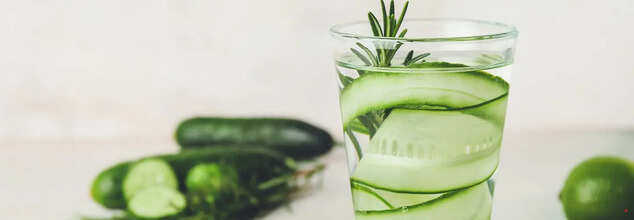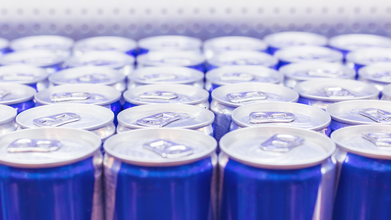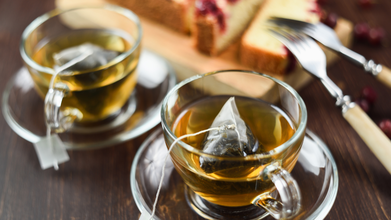- Health Conditions A-Z
- Health & Wellness
- Nutrition
- Fitness
- Health News
- Ayurveda
- Videos
- Medicine A-Z
- Parenting
Why Should You Drink Cucumber Water?

Cucumber water (Credit: Canva)
Cucumber water is a flavorful, nutrient-rich, hydrating drink that is made by infusing cucumber slices into drinking water. This drink is rich in antioxidants, lowers blood pressure and supports healthy skin.
Cucumber water is a great drink for dehydration, particularly for those who hate drinking water. Cucumber itself is 96% water, making it one of the most water-rich food. Besides, it is loaded with vital nutrients like Vitamin-C, Beta Carotene, Manganese, Molybdenum and antioxidants. As its popularity grows, more and more people are enjoying this healthy, refreshing drink at home. And why not? It's delicious and easy to make.
Here Are Seven Ways Cucumber Water Benefits Your Body
1. It keeps you hydrated
Your body can’t function properly without water. Most people should aim to drink six to eight glasses of water per day, according to the American Academy of Family Physicians. We know we’re supposed to drink water throughout the day, but sometimes plain water gets boring. Adding cucumber gives it some extra flavour, encouraging you to drink more.
2. It helps with weight loss
If you’re trying to lose weight, replacing sugary sodas, sports drinks, and juices with cucumber water can help you cut some serious calories from your diet. Staying hydrated also helps you feel full. Sometimes your body confuses thirst with hunger. But how will you know the difference? Reach for a tall glass of cucumber water first. If your hunger goes away after finishing the drink, you are thirsty. If you’re still hungry, then you know it’s hunger.
3. It delivers antioxidants
Antioxidants are substances that help prevent and delay cell damage from oxidative stress caused by free radicals. Oxidative stress can lead to chronic conditions like diabetes, cardiovascular diseases, cancer, and Alzheimer's amongst others. Research has shown that antioxidants may be able to reverse or stop this damage.
4. It may help prevent cancer
Some early research suggests that cucumbers may help in the fight against cancer. Along with antioxidants, cucumbers also have compounds called cucurbitacins and a group of nutrients called lignans, which may have a role in protecting us from cancer. One study in the Journal of Cancer Research suggested that the dietary flavonoid fisetin, which is found in cucumbers, might help to slow the progression of prostate cancer.
5. It lowers your blood pressure
One contributing factor to high blood pressure is having too much salt (sodium) and too little potassium in your diet. The excess salt causes your body to hold fluids, which raises blood pressure. Potassium is an electrolyte that helps regulate the amount of sodium retained by the kidneys.
6. It supports healthy skin
Cucumber water can help soothe your skin from the inside out. Staying hydrated helps your body to flush out toxins and maintain a healthy complexion. Cucumbers are also high in pantothenic acid or vitamin B-5, which has been used to treat acne. One cup of sliced cucumbers has about 5 per cent of the recommended daily value of vitamin B-5.
7. It boosts bone health
Cucumbers are high in vitamin K. In fact, one cup of sliced cucumbers has about 19 per cent of the recommended daily value. Your body needs vitamin K to help form proteins that are needed to make healthy bones and tissues as well as to help your blood clot properly.
How Energy Drinks Nearly Killed a Healthy 54-Year-Old Runner

Credits: Canva
An absolutely fit and healthy man, 54, a runner too, a non-smoker, non-drinker and off the drugs, suffered a stroke that caused permanent damage to him. This is after he consumed energy drinks. It all started when he suddenly noticed a weakness in his left side of the body. It started with numbness and difficulties with balance, walking, swallowing and speech. This is when his family member rushed him to a nearby stroke clinic.
According to CNN: “His blood pressure was sky high, about 254 over 150 millimeters, yet when you looked at him you’ve never know it, because he looked so well. That’s why we call hypertension the silent killer,” said Dr. Sunil Munshi, a consulting physician at Nottingham University Hospitals NHS Trust in the United Kingdom.
The man was a warehouse worker from Sherwood, Nottingham and the case is published in BMJ Case Reports, with Munshi being the senior author of the paper.
A Stroke Without A Clear Cause
As per Dr Munshi, the patient arrived at the hospital with numbness on his left side. Scans revealed a stroke in the thalamus, a deep part of the brain responsible for balance and coordination.
“His left side was numb, and scans showed he had a stroke in the deeper part of the brain, the thalamus, which explains the unsteadiness,” Dr. Munshi said. The man was admitted, and doctors began aggressive treatment. He required five different medications before his blood pressure fell to 170. Normal adult blood pressure is below 120 over 80 millimeters of mercury. Readings of 180 over 120 or higher qualify as a medical crisis.
Once discharged, the situation worsened. At home, his blood pressure rose again, reaching 220 despite continued treatment. With no clear medical cause, doctors conducted extensive tests. Everything came back negative.
The Hidden Clue: Eight Energy Drinks a Day
The breakthrough came only when the man casually mentioned his daily habit. To stay alert on long shifts, he drank eight highly potent energy drinks every day, two cans at four separate points. Each can contained about 160 milligrams of caffeine.
“Suddenly the diagnosis was clear,” Dr. Munshi said.
Study first author Dr. Martha Coyle noted that some energy drinks contain up to 500 milligrams of caffeine per can. For comparison, tea has about 30 milligrams and coffee about 90. In the United Kingdom, adults are advised to consume no more than 400 milligrams of caffeine a day. This man was taking in more than 1,200 milligrams, about triple the recommended limit. The US Food and Drug Administration gives the same advice.
After he stopped drinking energy beverages entirely, his blood pressure returned to normal within weeks. He is healthy today, but the stroke left lasting effects.
“I obviously wasn’t aware of the dangers,” the man told his doctors. “I have been left with numbness on the left side, in my hand, fingers, foot and toes even after eight years.”
Why Energy Drinks Can Be Dangerous
Researchers say the problem extends far beyond caffeine. Many energy drinks contain taurine, an amino acid that can raise blood pressure even more when combined with caffeine. High sugar levels also contribute to blood vessel damage.
“These drinks contain combinations of ingredients that increase blood pressure, affect metabolism and may damage blood vessels,” Dr. Munshi said. The beverages often include ginseng, guarana, theophylline and theobromine, all stimulants that can further strain the cardiovascular system.
Doctors have documented cases of cardiac arrhythmias, hemorrhages and strokes linked to heavy energy drink use. Some young adults combine them with cocaine or methamphetamine, a mix Munshi described as capable of causing “havoc.”
A Call for Greater Awareness and Regulation
Munshi believes this case should push doctors to ask patients about energy drink use, especially younger individuals presenting with heart issues or stroke-like symptoms. He said the drinks have become more potent over time and may warrant stricter regulation and clearer public warnings.
“We propose increased regulation of energy drink sales and advertising, which are often targeted at younger ages,” he said.
Are You One Of The Six Types Of People Who Cannot Have Green Tea? Here’s What You Can Have Instead

Credits: iStock
Green tea is healthy. A statement we hear every now and then. It surely is a healthier option, but how healthy is it really? Can everyone drink green tea? Or is it only for some people, while others may have to find alternatives?
Well, first things first, green tea is actually a healthier option, however, a 2024 study published in Chemosphere shows that the tea bags these green teas are sold in expose the consumers to microplastics. This means while green tea in its purest form is healthy, the packaging may actually be harmful. What is even more surprising is that there could actually be certain people who cannot drink green tea. Are you one of them? Let's find out.
Here are the 6 kinds of people who cannot drink green tea. But, worry not, we also have some alternatives for you!
Are You Someone With Chronic Stomach Issues?
Green tea contains catechins, these are antioxidants that make green tea better than the tea we usually drink. However, they can also irritate your stomach lining and alter acid levels. These catechins increase the production of stomach acids and it could lead to discomfort, bloating, constipation, and could even worsen your acid reflux and ulcers. This is, given that you already struggle with stomach issues.
The best thing to do? Do not consume green tea on an empty stomach. Ensure that you have eaten something before you go take a sip of it.
Do You Have Anemia? Green Tea Could Make It Worse
The same catechins that we talked about earlier could in fact block the absorption of iron in your body. This could cause anemia. In fact, a 28-year-old Lynn Shazeen, who was a Matcha-enthusiast, the purest form of green tea, ended up in the ER due to 'dangerously low iron levels'. The reason? You guessed it right. She drank too much Matcha, as a result, her iron levels went down from 23 to 13.
What can you do instead? Make sure that you are consuming enough iron otherwise. Include vitamin C-rich food in your diet, as they too can help boost iron absorption.
Green Tea May Not Be The Best Pregnancy Practice
If you are pregnant or a breastfeeding mother, consuming large amount of green tea could affect your baby's health. The caffeine in green tea could increase the risk of miscarriage and the catechins could interfere with folic acid absorption. These two passed to the baby through breast milk could overstimulate the baby.
What can you do? Experts say that new mothers or pregnant women must limit their intakes to no more than 2 cups a day.
Caffeine Sensitive People
If you are someone who does not react well to caffeine, do not drink green tea. Yes, green tea is sold as a healthier alternative, but not because it is caffeine-free, but because the amount of caffeine is less. An 8-ounce cup of green tea has somewhere between 20 to 45mg of caffeine, compared to a cup of coffee that has 95mg.
What can you do instead? Go for non-caffeinated drinks like juices, chamomile teas, or turmeric latte to ditch your Matcha latte.
Away From The Kids, Please
Like we do not let our kids drink tea; green tea comes under the same category. The caffeine content in it could overstimulate their nervous system. Green tea also contains tannins, which gives it its bitter taste, this could block the absorption of important nutrients and could even make your kid anemic.
What to do instead? You can give your young ones unsweetened milk, or coconut water for some taste. Talk to a nutritionist to ensure that whatever drink you give your kids do not spike their blood sugar levels.
If You Have Any Of These Health Conditions, You May Not Want To Drink Green Tea
If you have:
- Anxiety disorders
- Bleeding disorders
- Heart rhythm problems
- Diabetes
- IBS or diarrhea
- Liver disease
Then, it is best to stay away from green tea, as caffeine and tannins could further make your conditions worse.
So, What Are The Safer Alternatives?
You can go with herbal tea like chamomile, or lemongrass. They are great alternatives to green tea, and also do not contain any caffeine. You can also add a little cinnamon to make it flavorful.
The alternatives are as followed:
Hibiscus Tea
- Lemongrass Tea
- Chamomile Tea
- Turmeric Latte
- Coconut Water
- Rose Tea
- Oolong Tea
You can also add a little cinnamon to make it flavorful. While giving up tea could be hard, as the ingredients in it are what makes it addictive, however, the first step is always the harder one. Once you make the first move, which is to find an alternative, all that is left for you is to make it a routine. Voila! You are now healthier.
Disclaimer: Before making any changes in your diet, always consult your GP or a registered Nutritionist.
Is Ozempic Really Better Than A Longevity Diet For Losing Weight? Nutritionist Explains

Credits: Canva
Weight loss is one of the most discussed health topics today, with countless strategies promising results. Two approaches that have gained attention recently are the use of Ozempic, a medication designed to regulate appetite and metabolism, and the longevity diet, a mindful, whole-food approach aimed at long-term health benefits. But which is truly more effective for shedding pounds and maintaining overall well-being?
We got in touch with Dr. Pratyaksha Bhardwaj, World Record Holder Dietician and Weight Management Expert, who shared her insights on how both methods work and which might suit different individuals.
What is Ozempic?
Ozempic is a prescription medication that helps regulate appetite by acting on the digestive system and influencing metabolic pathways. Dr. Bhardwaj explains, “Ozempic works quickly because it impacts the hormones that control hunger, making it easier for people to reduce their calorie intake.”
This medication is particularly useful for individuals struggling with obesity, insulin resistance, or difficulty maintaining long-term weight loss. “For people who need rapid results or are starting their weight loss journey, Ozempic can provide a significant boost,” says Dr. Bhardwaj.
However, she also cautions that Ozempic requires medical supervision and carries potential side effects. Without lifestyle changes, there is a risk of regaining weight once the treatment stops.
What is the Longevity Diet?
The longevity diet is a plant-focused way of eating that also includes periods of a fasting-mimicking diet to support long-term health. It encourages meals built around vegetables, fruits, whole grains, legumes, and nuts, while cutting back on red meat, packaged foods, and sugary items. The plan is grounded in scientific research and combines everyday nutritious eating with short stretches of a controlled, low-calorie, fully plant-based diet a few times each year.
As per Everyday Health, the diet centres on mostly plant foods, with plenty of leafy greens, seasonal fruits, whole grains, beans, lentils, nuts, and seeds. Olive oil and other healthy fats are used regularly. Protein comes mainly from plant sources, though a few servings of low-mercury fish may be included each week. It calls for limiting red and processed meats, sweets, and refined grains. Some versions suggest keeping meals within a twelve-hour window, such as between morning and early evening.
Unlike Ozempic, the longevity diet is a long-term, holistic approach to eating. Dr. Bhardwaj describes it as “a diet based on whole foods, mindful eating, timing meals according to your circadian rhythm, and creating sustainable metabolic health.”
While results are slower, the longevity diet promotes cellular integrity, reduces inflammation, balances gut health, and builds lasting healthy habits. “This isn’t a quick fix,” Dr. Bhardwaj notes, “but the benefits extend beyond weight loss, supporting overall health for the long term.”
Which One is Better?
Determining which approach is better depends largely on individual goals, medical history, and lifestyle. According to Dr. Bhardwaj, “Ozempic can provide momentum and jumpstart weight loss, especially for those facing metabolic challenges, but the longevity diet ensures long-term sustainability and better overall health.”
She emphasizes that combining knowledge from both approaches can sometimes be the most effective strategy. “Using Ozempic under medical supervision to get started, while gradually incorporating the principles of a longevity diet, can help people achieve both short-term results and long-term wellness.”
Ultimately, choosing between Ozempic and the longevity diet isn’t about one being universally better than the other, it’s about finding the method that fits your body, lifestyle, and long-term health goals.
© 2024 Bennett, Coleman & Company Limited

